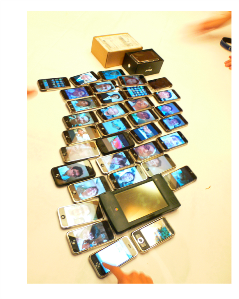I had the opportunity to attend the virtual ELI Spring Focus Session today on Mobile Learning 2.0.
As the program noted:
“Although mobile learning has different meanings for different communities, we know that learning is deepened and enriched when students have options for their learning for multiple paths through course content. Mobile technology not only enables students to take their learning with them beyond the physical walls of the classroom, but it also makes possible a new array of interactions in the classroom as well. Mobile learning encompasses participating in learning activities anywhere, at any time, and utilizing mobile technologies that are rapidly evolving. Possible applications of mobile technology include enabling authentic learning engagements (such as real-time data collection), spontaneous mash ups (such as populating a map with local data), synchronous interactions with classmates and subject experts, and a rich variety of interactions with course content. Precisely because of its fluidity and independence from physical boundaries, mobile learning offers vast potential to enhance all types of instruction: face-to-face, blended, and online. The goal of this focus session is to re-assess the potential of mobile technologies and identify new ways in which mobility can contribute to the learning experience.”
I have a not-so-smart phone, but also an iPod Touch, so I went to see how others are leveraging mobile devices for learning. What was interesting was what I saw and what I did not see.
First, some amazing exchanges were occurring both in the Adobe Connect chat room and more importantly, in a backchannel on Twitter (using the hashtag #elifocus). There was a vibrant discussion occurring around the concept of mobile learning, and as my Twitter stream reflects, I was certainly engaged:
At the same time, while we were discussing new school ideas, I was struck by how the majority of presenters were using old school methods. Garr Reynolds‘ Presentation Zen should be required reading for presenters these days. Too many presentations consisted of wordy text-only slides. The only presenter who strayed from this old format was the Stanford undergrad who also happens to be director of Blackboard Mobile, Aaron Wasserman. He shared his desktop to demonstrate how iStanford was developed (and later bought by Blackboard). Some of the presentations were more administrative in nature, but for leveraging mobile devices for learning, I enjoyed Shan Evans presentation on MOCA (Mobile Ongoing Course Assessment) and John Shannon’s discussion on Enabling Personalized Learning. ELI had a good format mixing presentations with chat sessions and 10-minute lightening rounds.
So what I saw was a couple of sessions actually on student learning, as well as a dynamite backchannel conversation (enhanced by those physically present at VCU). What we did not see (yet) was real cutting edge use of mobile devices. Many of the presentations demonstrated what Everett Rogers and Marshall McLuhan have noted in the past – that faculty continue to use new technologies to do what they are already doing. It would be nice to see these new affordances used in ways that push learning and the four walls of the classroom (or LMS). We will see what happens tomorrow in the second day of the conference.


![Reblog this post [with Zemanta]](http://img.zemanta.com/reblog_e.png?x-id=f11b1357-0935-4d30-a736-913c965fdfdc)
Nice overview of our experience. The highlight for me was John Shannon’s elaboration on how mobile learning is occuring in the field & creative uses of mobile tech to engage learners in new ways. There was a statement to the effect that these learning opportunities are all beta. I love that open minded approach. I’m also intrigued by the chicken/egg proposion re pedagogical need vs technology. Can’t either inform the other?
On another note, I think attitude plays an important role in the educational use of mobile tech in learning. My workstation is a MacBook Pro, I use my iPhone as a mulifacited computing device, I carry a still & Flip camera & I feel ready to learn & contribute at most any time. Viva la mobile computing!
Great post.Love to read more.
bba